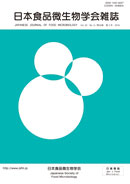Volume 33, Issue 3
Displaying 1-12 of 12 articles from this issue
- |<
- <
- 1
- >
- >|
Review
-
2016Volume 33Issue 3 Pages 97-106
Published: September 30, 2016
Released on J-STAGE: January 20, 2017
Download PDF (1323K)
Special Lecture
-
2016Volume 33Issue 3 Pages 107-113
Published: September 30, 2016
Released on J-STAGE: January 20, 2017
Download PDF (881K)
Symposium I: Current problems in the microbiological control of food and food testing
-
2016Volume 33Issue 3 Pages 114
Published: September 30, 2016
Released on J-STAGE: January 20, 2017
Download PDF (165K) -
Recent Trends of Foodborne Bacterial Pathogens and Fungi Becoming Clear by Administrative Inspection2016Volume 33Issue 3 Pages 115-120
Published: September 30, 2016
Released on J-STAGE: January 20, 2017
Download PDF (559K) -
2016Volume 33Issue 3 Pages 121-126
Published: September 30, 2016
Released on J-STAGE: January 20, 2017
Download PDF (569K) -
2016Volume 33Issue 3 Pages 127-133
Published: September 30, 2016
Released on J-STAGE: January 20, 2017
Download PDF (666K) -
2016Volume 33Issue 3 Pages 134-137
Published: September 30, 2016
Released on J-STAGE: January 20, 2017
Download PDF (277K)
Short Papers
-
2016Volume 33Issue 3 Pages 138-141
Published: September 30, 2016
Released on J-STAGE: January 20, 2017
Download PDF (359K) -
2016Volume 33Issue 3 Pages 142-149
Published: September 30, 2016
Released on J-STAGE: January 20, 2017
Download PDF (275K)
Epidemiologies
-
2016Volume 33Issue 3 Pages 150-154
Published: September 30, 2016
Released on J-STAGE: January 20, 2017
Download PDF (296K) -
2016Volume 33Issue 3 Pages 155-159
Published: September 30, 2016
Released on J-STAGE: January 20, 2017
Download PDF (233K) -
2016Volume 33Issue 3 Pages 160-165
Published: September 30, 2016
Released on J-STAGE: January 20, 2017
Download PDF (374K)
- |<
- <
- 1
- >
- >|
